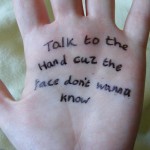The sound you hear is the radiation emitted by the wireless router and the iPad. This radiation affects our bodies and is especially toxic for children.
Category: children
Santa Clara County MD warns: Internet and Wi-Fi in schools can affect learning
Cindy Lee Russell, M.D., Vice President of Community Health, Santa Clara County Medical Association wrote an article warning about the health risks of technology in schools: Shallow Minds: How the Internet and Wi–Fi in Schools Can Affect Learning
Dr. Russell writes: “There are a host of concerns with classroom technology, and the virtual world it creates, that have not been explored in the rush to “modernize” education and prevent our kids from becoming “computer illiterate,” despite the fact that computers are designed for ease of use. These issues range from distraction in the classroom, impairment of cognitive development and long-term memory, deficiency in learning social skills, Internet addiction, cyber bullying, access to inappropriate content, eye fatigue,and security risks to online learning networks. In addition, the sheer cost of computers and continuous upgrades is likely to break many school budgets. We have not mentioned the issue of toxic e-waste, another growing public health problem.”
“We will not get rid of the Internet or computers. We should not ignore, however, the enlarging body of science that points to real threats to public health and, especially, our children’s safety and well-being. The best approach is precautionary. Reduce the risk by reducing the microwave emissions. It is our obligation as physicians and parents to protect our children. They are the future and our legacy.”
Dr. Russell recommends:
- Remove wireless devices (white boards and routers) in schools in favor of wired connections and fiberoptic.
- If there is Wi-Fi, then give teachers the authority to turn it off when not in use or if they feel it is not necessary.
- Ban cell towers near or on schools.
- Limit screen time on computers.
- Limit or ban cell phone use in the class
- Limit or ban cell phone use at home
- Do not allow laptops to be placed on laps
- Undertake independent scientific studies on Wi-Fi and computer use that look at acute and long-term health effects.
- Train teachers how to recognize symptoms of EMF reactions.
- Conduct meetings with parents and teachers to address this issue in each school.
Dr. Russel cites the science, international actions, and provides a reference list. This is an excellent paper to give to school principals and administrators.
Dad’s win school wi-fi battle
 New Zealand dad’s concerned for the health and safety of school children have a won a battle against a local school to have the wi-fi removed and use wired connections instead.
New Zealand dad’s concerned for the health and safety of school children have a won a battle against a local school to have the wi-fi removed and use wired connections instead.
Damon Wyman and David Bird led a campaign to remove the wireless system from Te Horo School and replace it with cable-based internet due to concerns it could cause cancer and other health problems.
Damon is the father of Ethan who died from a brain tumor and had attended the local school. His son was exposed to Wi-Fi at school, and he also slept with an Internet-connected iPod under his pillow at night.
The school sent a survey to parents, and after reviewing the results agreed to remove the wi-fi in the junior classrooms.
Cell phones linked to anxiety, lower grades, and unhappiness
 Almost everywhere you look someone has a cell phone pressed to their ear, or has one in their hand. Students depend on the devices to connect with friends and family.
Almost everywhere you look someone has a cell phone pressed to their ear, or has one in their hand. Students depend on the devices to connect with friends and family.
A recent study led by Kent State University researchers, surveyed more than 500 undergraduate students from 82 different majors. They recorded daily cell phone use along with anxiety and happiness levels. In addition student grades were included in the study.
Results were students who used their cell phones more had lower grades, higher anxiety, and less happiness relative to their peers who used the cell phone less.
Earlier this year, Kent researchers linked cell phone use to poor student fitness. These results suggest that people should be encouraged to reduce their cell phone use! Or, better yet, use them for emergencies only!
Safety tips for cell and cordless phone use: Learn more
Dr. Mercola’s comments on this study include raising awareness about second hand radiation effects.
Dr. Mercola writes: “Respect Others Who Are More Sensitive: Some people who have become sensitive can feel the effects of others’ cell phones, iPads, and other gadgets in the same room, even when it is on but not being used. If you are in a meeting, on public transportation, in a courtroom or other public places, such as a doctor’s office, keep your cell phone turned off out of consideration for the “secondhand radiation” effects. Children are also more vulnerable, so please avoid using your cell phone near children.”
Can cell phones cause autism?
Most people do not know that cell phones and wireless devices can affect unborn children. A new study reports exposures from electromagnetic fields and wireless radiation may contribute to autism. Autism now affects about one in 88 children with a staggering cost estimated at $137 billion per year in the US.
In the 1970’s, before widespread use of cell phones autism was a comparatively rare health issue. Today, autism is so prevalent that the Centers for Disease Control call it a national health crisis.

 Co-authors Dr. Martha Herbert and Cindy Sage have integrated the results of over 550 scientific studies that report biological effects of electromagnetic radiation and wireless exposures, and of common biology and brain problems in autism.
Co-authors Dr. Martha Herbert and Cindy Sage have integrated the results of over 550 scientific studies that report biological effects of electromagnetic radiation and wireless exposures, and of common biology and brain problems in autism.
Many of the behavioral and biological characteristics seen in autism are similar or identical to those produced by typical daily exposures to cell and cordless phone radiation, cell towers, baby monitors, wireless tablets, WI-FI and other sources of pulsed electromagnetic radiation. But, personal choices can make a big difference in lowering exposure for pregnant women, infants and the whole family.
Dr. Martha Herbert, PhD, MD of Harvard Medical School and a pediatric neurologist with Massachusetts General Hospital says “such exposures can have a disorganizing effect on the brain’s ability to learn and remember, and can be destabilizing to immune and metabolic function”.
Children are more vulnerable than adults to environmental toxins, and can be affected in-utero as well as during the rapid growth of early childhood. Brain and nervous system in young children appear to be particularly sensitive.
The CHE EMF Working Group hosted a teleconference call with Cindy Sage and Dr. Herbert.
Students demonstrate wireless hazards at Science Faire
Two young scientists researched and studied wireless health risks for science fair projects. One student was interested in the controversy surrounding wi-fi and whether it should be in schools or not. She found fruit flies exposed to industrial wi-fi had genome mutations. Another student researched mobile phone radiation and warns about brain cancer, insomnia and other health problems.
In May of 2013 a team of Danish 9th grade girls did a science study on wi-fi and found watercress seeds would not grow near a wi-fi router.
The students placed six trays filled with water cress in a room without radiation, and six trays in another room next to two wi-fi routers. Over the next 12 days, the girls observed, measured, weighed and photographed their results. The cress seeds placed near the routers had not grown, whereas the cress seeds in the other room, away from the routers, thrived.
 The experiment earned the girls top honors in a regional science competition and the interest of scientists around the world. Full story here: Student Science Experiment Finds Plants won’t Grow near Wi-Fi Router
The experiment earned the girls top honors in a regional science competition and the interest of scientists around the world. Full story here: Student Science Experiment Finds Plants won’t Grow near Wi-Fi Router
Belgium bans sales and advertising of mobile phones for children under 7
New regulation for the sale of mobile phones in Belgium
As of 1 March 2014, new regulations will apply to the sale of mobile phones. On the one hand the sale of mobile phones that have been specially manufactured for young children (under 7s) will be prohibited. On the other hand the SAR value will have to be listed everywhere where mobile phones are sold: in stores as well as for distance sales over the Internet.
Sale of children’s mobile phones prohibited
As of 1 March 2014, mobile phones that are specially designed for young children may no longer be introduced to the Belgian market. This concerns customized mobile telephones suitable for children younger than 7 years of age, for instance having few buttons and a shape attractive for children. Additionally, from this date forward, no advertising may be made for mobile phone use among the same age group.
The specific absorption rate (SAR) to become mandatory consumer information
When you purchase a new mobile phone, from now on you will be able to choose your new device based on the specific absorption rate (SAR). The SAR value is different for every mobile phone. The SAR value will have to be indicated along with the other technical specifications, not only in the shop, but also for distance sales over the Internet.
Why these measures?
As a precaution. According to the International Agency for Research on Cancer (IARC, 2011) there may be an increased risk of brain cancer due to the intensive use of a mobile phone. The IARC has therefore classified radio frequency as “possibly carcinogenic”. Measures are being taken pending clearer scientific conclusions. The intention is to raise awareness among mobile phone users.
Children already come into contact with mobile phones from a very young age. The overall exposure during their lifetime will thus be greater than that of today’s adults. Moreover, children absorb more mobile phone radiation than adults (twice as much in the brain and 10 times more for skull bone marrow). This is already a reason for additional caution, given the classification of radio frequency as “possible carcinogenic” by the International Agency for Research on Cancer (IARC).
This information above is taken from the press release of “The Federal Public Service (FPS) Health, Food Chain Safety and Environment.”
Sebastopol school board approves wireless computers for kids
The Sebastopol Unified School District (SUSD) unanimously approved funding for wireless computers in two elementary schools (K-5) and (K-8).
 The Superintendent declared wireless was safe, despite health warnings from science and medical experts, which were reviewed, but ultimately ignored. One board member expressed concern about increasing screen time for kids, and another about the placement of routers, but no precautions were included in the decision.
The Superintendent declared wireless was safe, despite health warnings from science and medical experts, which were reviewed, but ultimately ignored. One board member expressed concern about increasing screen time for kids, and another about the placement of routers, but no precautions were included in the decision.
The request for a hard wired computer lab, which would be safer, faster, more secure and more reliable was countered with a letter signed by a couple dozen parents who urged the board to “invest the funds in computer infrastructure that is portable, wireless and cost effective.” Reasons included fears of declining enrollment and children’s inadequate preparation for today’s technological society. The letter states,”Key to their [children’s] professional success, social integration and economic sustainability, and therefore their health will be their ability to navigate the world of technology…”
The push for computers in the classroom is part of Common Core State Standards, the new federal curriculum which has been sharply criticized as eliminating community-based planning, and instead of fostering education for individual need and the common good, it puts children on a treadmill to become scared, obedient workers for the global economy.
 Sebastopol’s initial plan is to purchase 60 wireless computers, 30 for each school and store them on a cart which teachers can bring into the classroom. While this plan is considerably modest compared to what other schools have deployed, (the Los Angeles School District is giving every student an iPad) it’s unknown if or when a 1:1 computer for every child will happen in Sebastopol.
Sebastopol’s initial plan is to purchase 60 wireless computers, 30 for each school and store them on a cart which teachers can bring into the classroom. While this plan is considerably modest compared to what other schools have deployed, (the Los Angeles School District is giving every student an iPad) it’s unknown if or when a 1:1 computer for every child will happen in Sebastopol.
It is also unknown how many, or where, additional routers will be installed. The routers will increase the radiation exposure for children, teachers, and staff, even when the cart is not in use.
 Children who have medical conditions (headaches, heart palpitations, medical implants, seizures, EMF sensitivity) are at risk in a wireless environment. The public school may become inaccessible for them, or they may be isolated from peers when the computers are being used. In Canada a lawsuit has already been filed against wi-fi in school.
Children who have medical conditions (headaches, heart palpitations, medical implants, seizures, EMF sensitivity) are at risk in a wireless environment. The public school may become inaccessible for them, or they may be isolated from peers when the computers are being used. In Canada a lawsuit has already been filed against wi-fi in school.
A common misconception, which is used to downplay the health risks, is to promote the idea that wi-fi is already everywhere. That’s similar to thinking engine exhaust is already everywhere, so reducing car trips by walking and biking to school is unnecessary. It does not justify increasing wi-fi, and misses an important point. Being closer to the source of pollution matters greatly. Imagine breathing the fumes behind a bus, compared to knowing there are exhaust particulates in the air. Ambient wi-fi signals are not the same as being in a room with 30 wi-fi computers, or being near routers which are always on.
 The Alliance for Childhood wrote, “Fool’s Gold: A Critical Look at Computers in Childhood”. They caution, ” Those who place their faith in technology to solve the problems of education should look more deeply into the needs of children. The renewal of education requires personal attention to students from good teachers and active parents, strongly supported by their communities. It requires commitment to developmentally appropriate education and attention to the full range of children’s real low-tech needs- physical, emotional, and social, as well as cognitive.”
The Alliance for Childhood wrote, “Fool’s Gold: A Critical Look at Computers in Childhood”. They caution, ” Those who place their faith in technology to solve the problems of education should look more deeply into the needs of children. The renewal of education requires personal attention to students from good teachers and active parents, strongly supported by their communities. It requires commitment to developmentally appropriate education and attention to the full range of children’s real low-tech needs- physical, emotional, and social, as well as cognitive.”
Parents everywhere beware! Common Core is bringing computer testing into the schools and giving the government a whole new tool to track and profile children.
